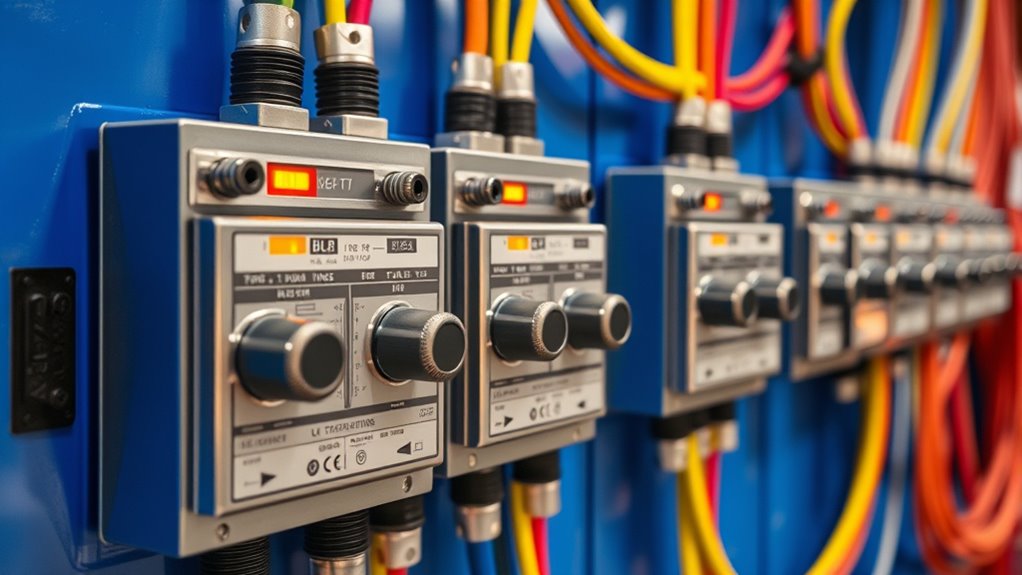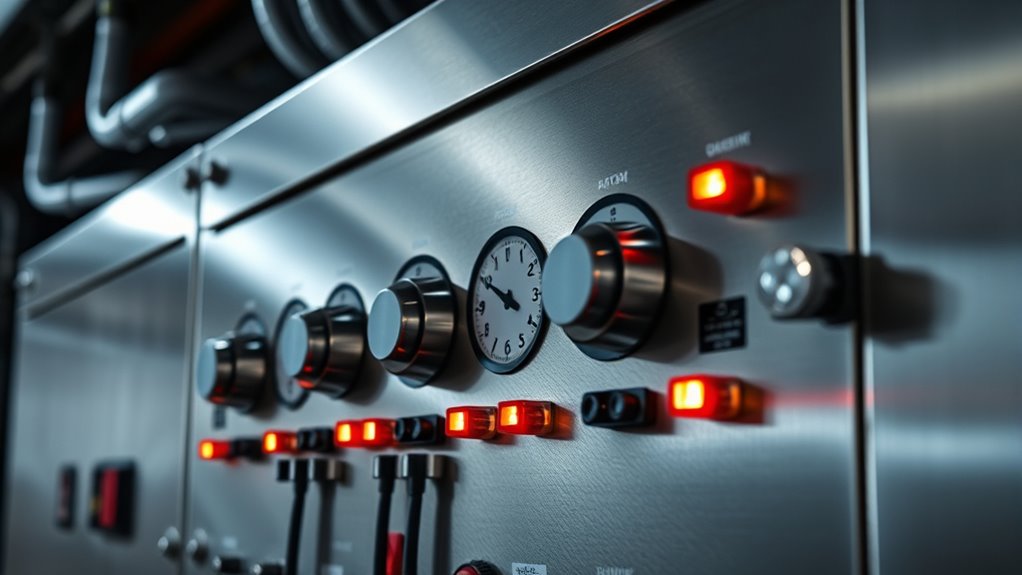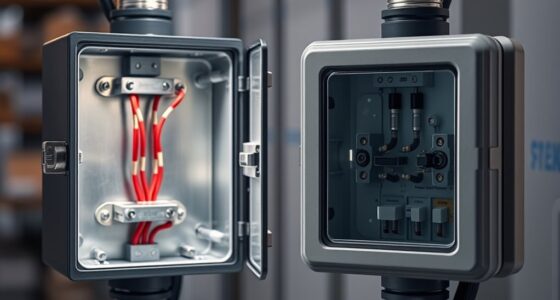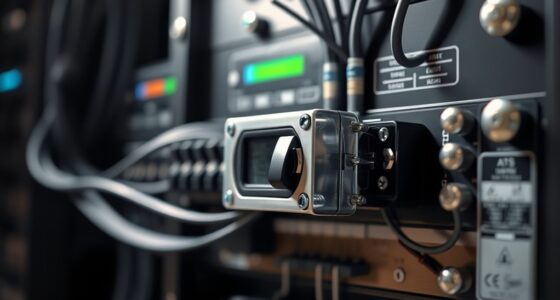UL 1008 standards guarantee that transfer switches are designed, tested, and certified for safety, performance, and durability. They specify requirements for electrical ratings, construction, and operational reliability, helping you choose equipment that can safely handle power transitions during outages. Meeting UL 1008 means the switch effectively prevents shorts, arcing, and overheating. To get a clearer understanding of what makes a UL 1008-compliant transfer switch reliable, keep exploring these standards further.
Key Takeaways
- UL 1008 sets safety and performance standards for transfer switches used in residential, commercial, and industrial applications.
- It covers electrical ratings, construction quality, and operational reliability to ensure safe power transitions.
- Certification through UL 1008 involves rigorous testing to verify compliance with safety benchmarks.
- UL-marked transfer switches demonstrate durability, electrical integrity, and resistance to faults like arcing or overheating.
- Choosing UL 1008-certified switches enhances safety, reduces hazards, and ensures reliable operation during power outages.

When selecting a transfer switch, understanding the UL 1008 standards is essential to guarantee safety and reliability. These standards set the benchmark for how transfer switches should be designed, tested, and manufactured to ensure they perform safely during power transitions. Making certain transfer switch safety is your top priority, especially given the critical role these devices play in emergency power systems. The UL certification process involves rigorous testing that verifies a transfer switch meets specific safety criteria, giving you confidence that the product can handle real-world conditions without risking electrical faults or failures.
UL 1008 covers various aspects of transfer switch safety, including electrical ratings, construction standards, and operational performance. It requires that switches are built with durable materials and proper insulation to prevent shorts, arcing, or overheating. The certification process also assesses the switch’s ability to switch loads safely, smoothly disconnecting and reconnecting power sources without causing electrical shocks or fires. By adhering to these standards, manufacturers demonstrate their commitment to safety, which benefits you by reducing the risk of equipment failure or dangerous incidents during power transitions.
When a transfer switch bears the UL mark, it indicates that it has undergone the UL certification process and successfully passed all tests outlined in UL 1008. This certification is a clear sign that the switch meets recognized safety standards and is suitable for residential, commercial, or industrial use. It’s important to know that not all transfer switches are UL-listed; choosing one with UL certification means you’re opting for a product that has been independently evaluated and verified for safety and quality. This reduces your liability and gives you peace of mind, knowing the switch has been tested under strict conditions that mimic real-world scenarios.
Additionally, understanding the UL 1008 standards helps you make informed decisions when selecting a transfer switch. Look for the UL mark when purchasing, and review the product documentation to confirm compliance. This process guarantees that the switch has been tested for electrical integrity, mechanical durability, and safe operation over its lifespan. Remember, the UL certification process isn’t just about meeting regulations; it’s about safeguarding your property and loved ones by choosing equipment that has been thoroughly vetted for safety. Ultimately, prioritizing UL-certified transfer switches helps you avoid potential hazards, ensures reliable operation during outages, and aligns your setup with industry best practices. Somatic therapy techniques can also be helpful in managing stress associated with electrical safety concerns, further supporting your well-being.
Frequently Asked Questions
How Often Should Transfer Switches Be Inspected for Compliance?
You should perform periodic maintenance and inspections of your transfer switches at least once a year to guarantee compliance and proper functioning. Regular inspection schedules help identify wear, corrosion, or loose connections that could cause failure during an emergency. By staying proactive with inspections, you reduce the risk of equipment failure, ensure safety, and maintain compliance with relevant standards. Always follow manufacturer recommendations for specific inspection intervals.
Are There Specific Testing Procedures Required by UL 1008?
You need to follow specific testing protocols outlined in UL 1008 to meet certification requirements. These procedures include verifying electrical ratings, mechanical operation, and safety features through rigorous testing. You should confirm the transfer switch undergoes routine testing to confirm it functions correctly under various conditions. Adhering to these protocols guarantees compliance, safety, and reliable performance, which are essential for certification and safe operation in your system.
What Are Common Issues Found During UL Compliance Inspections?
Imagine inspecting a well-oiled machine, only to find a few rusty gears. During UL compliance inspections, you often spot installation challenges like improper wiring or loose connections, which hinder performance. Labeling inaccuracies are common too, causing confusion during maintenance. These issues can be easily overlooked but are critical for safety and compliance. Addressing these problems promptly guarantees your transfer switch operates reliably when needed.
How Do UL 1008 Standards Differ for Residential vs. Industrial Transfer Switches?
You’ll find that UL 1008 standards emphasize residential safety for home transfer switches, requiring easy operation and reliable isolation to safeguard users. For industrial transfer switches, the focus shifts to industrial durability, demanding tougher construction and enhanced fault tolerance to handle heavy loads. These differences ensure that residential units prioritize safety and simplicity, while industrial switches meet strict durability and performance criteria to support demanding environments.
Can Existing Transfer Switches Be Upgraded to Meet UL 1008 Standards?
You might think upgrading existing transfer switches is impossible, but it’s often feasible with the right options. Investigate upgrade options to meet UL 1008 standards, and you’ll find solutions that address compliance challenges. While some switches require replacement, others can be retrofitted or modified to enhance safety and performance. Don’t assume it’s too late—explore your options to make certain your transfer switch conforms to current safety standards.
Conclusion
By understanding UL 1008 standards, you guarantee your transfer switch is as reliable as a trusted friend during a storm. These standards act as the blueprint for safety and performance, guiding you to choose the right device for your needs. Think of UL 1008 as the backbone that keeps your power transfer system strong and dependable, so you can face any blackout with confidence. Stick to these guidelines, and you’ll have peace of mind knowing your system is built to last.









